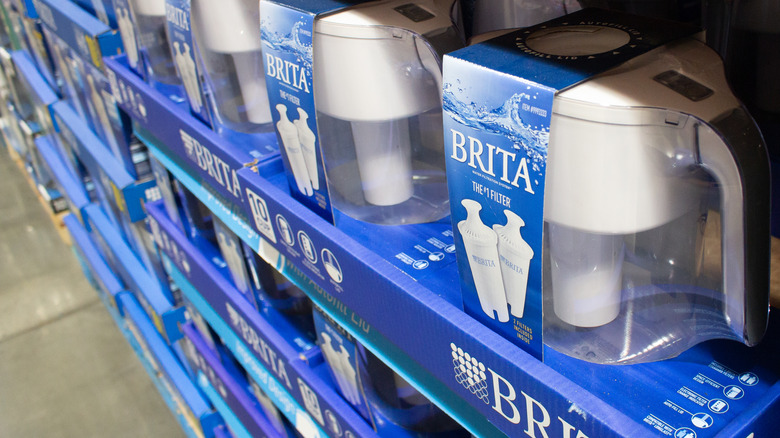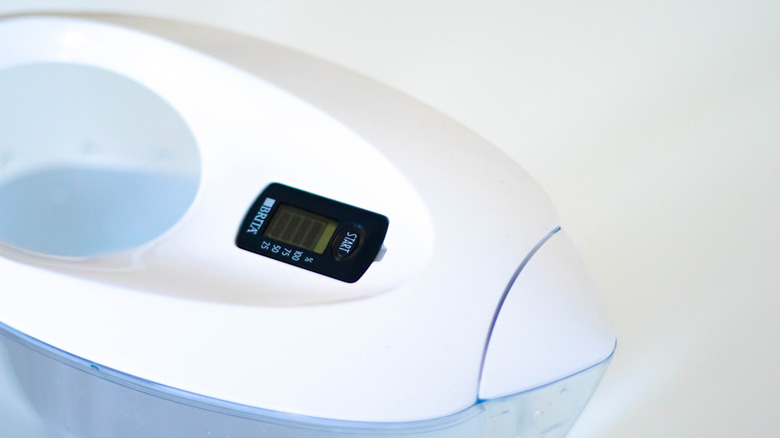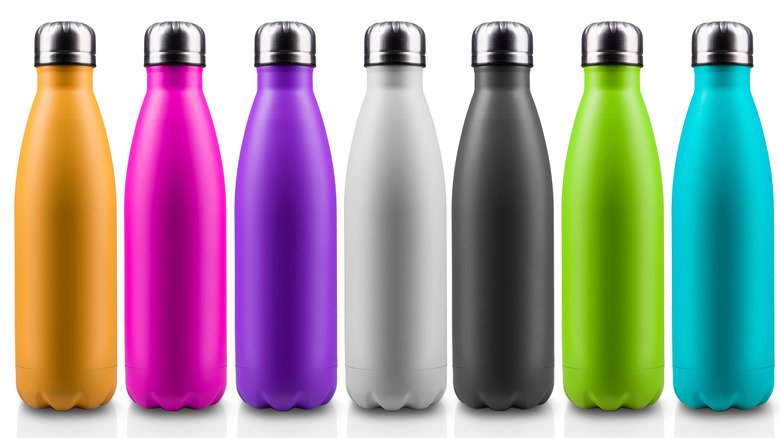How To Clean Mildew From A Brita Pitcher
Many water filtration pitchers are on the market, including Soma, AquaTru, and ZeroWater, but Brita may be the most recognizable brand found in kitchens and dorm room refrigerators nationwide. Each manufacturer uses a slightly different technology, but most, including the Brita water filter pitcher, contain an activated carbon filter to remove impurities and harmful chemicals, resulting in better-tasting tap water that's free of chlorine, lead, zinc, copper, benzene, asbestos, cadmium, and mercury.
Although it's easy to assume that a water pitcher doesn't get 'dirty,' a Brita needs periodic cleaning and maintenance to keep it effective — especially if you prefer room-temperature water and keep your dispenser on the counter; sunlight can cause algae to grow, so the company recommends storing a Brita in the refrigerator or a cool, dark place.
Since the pitchers are not dishwasher safe, improper or infrequent hand-washing can develop mildew in the creases and cracks around the lid and reservoir. While tiny black specks in the water, carbon particles from older filters, are safe to consume, according to Brita's website, signs of grim or mold should be removed. If washing the disassembled pitcher with mild detergent and warm water as recommended doesn't remove the mildew, a mixture of white vinegar, warm water, and a little elbow grease will do the trick.
Deep cleaning your Brita
Brita and other filtration pitchers should be deep cleaned every two to six months, depending on how frequently you use it. Consult the owner's manual for how often the filter should be replaced, and give the pitcher a thorough cleaning when you change it — or more often if you notice any slime or discoloration.
Start by removing the lid, reservoir, and filter from the pitcher. Discard the old filter and follow the instructions on preparing a new one. Wash the remaining parts in warm, soapy water using a soft sponge. Avoid abrasive sponges and detergents that will scratch the plastic.
Mildew, which can be a powdery white or gray growth, can be gently scrubbed away using a solution of one cup of warm water and one teaspoon of white vinegar. White vinegar contains acetic acid, which breaks down dirt, grime, and bacteria thanks to its antimicrobial properties. For stubborn areas, allow the parts to soak in the solution for 30 minutes to disinfect, or use a soft toothbrush to reach difficult areas.
Once clean, rinse the parts in hot, soapy water and allow them to air dry before reassembling. If vinegar's strong vapors are offensive to you, don't worry; the odor dissipates once the vinegar is washed away, and it won't taint the taste of your drinking water.
Additional kitchen items that may contain mildew
Unfortunately, your Brita pitcher isn't the only place mildew may be lingering in your kitchen. Thankfully, this warm water and white vinegar solution is also effective on other everyday kitchen items, and you can use up to a 1:1 ratio of water to white vinegar for tough spots.
The water bottles we carry around 24 hours a day need a deep cleaning to keep them sanitary. Remove any rubber or plastic parts and the filter – if it has one — to thoroughly clean all the pieces.
Use this solution to clean mildew from removable blender parts. Scrub the lid and gasket where the blade sits to avoid pureeing mold into your creamy soup recipe. If you have rubber spatulas with detachable handles, then there's likely mold there, too. Separate the two pieces and use the solution to scrub away mildew and bacteria. Always allow the parts to dry completely before reassembling, which may take longer if the handle is wooden.
One of the dirtiest things in the kitchen is the dishwashing sponge. You can usually smell the mildew before seeing it, but before you do, disinfect it regularly or replace it every two weeks to avoid spreading foodborne illnesses. Run it in the dishwasher each time you do a load, or soak the sponge in a vinegar and warm water solution for 30 minutes.



